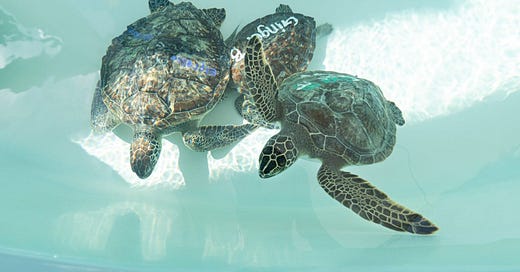One of my favorite family vacations was when we went to see the St. Louis Cardinals play in Jupiter, Florida during spring training. The kids were old enough to love baseball and young enough to still be excited about getting players’ autographs. We stayed at the Jupiter Beach Resort & Spa, a hotel right on the beach. It was colder in Jupiter than it was in St. Louis that spring break, so the kids weren’t too disappointed when they found out the beach was closed, especially when they learned the reason. Sea turtles were hatching.
Using Mike’s telephoto lens, we were able to see a few of the hatchlings from a distance. Intrigued, we planned a visit to the Loggerhead Marinelife Center to learn more about sea turtles. (My kids were never excited about learning on vacation, but I often snuck it in.) We learned why it was important to keep the blinds closed, so that the turtles, who rely on natural light to navigate, aren’t confused. We met some injured sea turtles, who were rehabilitating at the center. The visit sparked an interest in marine life for both kids.
We adopted a sea turtle for Dad for Father’s Day that year. My parents didn’t have to add a water feature to the farm. The “adoption” was honorary, a transfer of funds to take care of a specific turtle at the Loggerhead Marinelife Center. Loggerhead sent a stuffed turtle and information about the adopted turtle that the kids proudly presented to PawPaw as they shared all they had learned about these magnificent creatures.
That’s how I ended up on the Loggerhead email list. I’m a ruthless unsubscriber, going through email often to cut down on the clutter in my inbox. But I’ve never unsubscribed from that list. They reach out infrequently, and every time I see their emails, I remember our visit to meet the injured sea turtles, and Dad holding the stuffed turtle that almost fit in the palm of his big hand as he patiently listened to all of the sea turtle facts my kids had to offer. I still learn something new from the Loggerhead emails. Maybe marine biologist will be my second act career.
When an email arrived from Loggerhead this week, I learned about 17 cold-stunned green sea turtles who recently arrived at the center from Northern Florida. As a result of record cold temperatures, ocean temperatures dropped and these turtles became lethargic, lost mobility, and were unable to feed or swim. Loggerhead staff are monitoring their vital signs and providing antibiotics, fluids, and intravenous nutrition. Most of the turtles will be released in a few weeks, but some are in critical condition and will need to receive care for longer.
Photo Credit: Marissa Marulli
Green sea turtles have a relatively long lifespan and can live 70 years or more, according to the National Oceanic and Atmospheric Administration. (See, I can sneak learning in for you too!) But when their environment changes, they may be caught unaware. Stunned, they are unable to survive without intervention.
I’ve spent a lot of time lately thinking about who I am now as a result of changes that have happened to me. Who am I as I’ve grown older, moved into menopause, and been diagnosed with Parkinson’s disease? I am not the same person that I was before because these are all changes that happened to me.
But it seems even more difficult to answer the question of who am I now as the environment changes around me. What parts of me remain the same? What parts might change? I’ve spent a lot of time sensemaking this week as it becomes clearer that changes in society may impact people I love and the work that I do. The pace of change is fast, and the specific effects are unclear. Like the green sea turtles, I feel stunned.
What can we do when we’re stunned? Maybe I too need fluids (fruity beer) and nutrition (the Combine pizza from Scout’s Honor, topped with ham, bacon, and corn, because Iowa) and rest. I’m wondering if the staff at the Loggerhead Marinelife Center would monitor my vitals for a few weeks if I showed up on their door step. But, in another both/and moment, I also have to keep moving forward. There is work to be done.
I’ve been reading poetry lately because when words don’t come to me, I go looking for them, for words that are doing heavy lifting, carrying layers of meaning, like this excerpt from Maggie Smith’s poem, “Good Bones.”
. . . Life is short and the world
is at least half terrible, and for every kind
stranger, there is one who would break you,
though I keep this from my children. I am trying
to sell them the world. Any decent realtor,
walking you through a real shithole, chirps on
about good bones: This place could be beautiful,
right? You could make this place beautiful.
I am no longer trying to sell the world to my children. I showed them turtles and mountains and love and home runs, but they’ve also seen prejudice and greed, destruction and strife, hate. They are now old enough to make up their own minds about the world. Now, I’m trying to convince myself. This place has good bones, but can we still make it beautiful?





Love the poem you shared this week, Amy! May we all still hold on to the beauty and the hope in the world even when we’re stunned and scared! <3
I love those particular lines. I’m stunned too and will take your lead on sitting with poetry. AKB and I were reflecting and decided that great art over the coming months and years may be part of what returns beauty to this place.